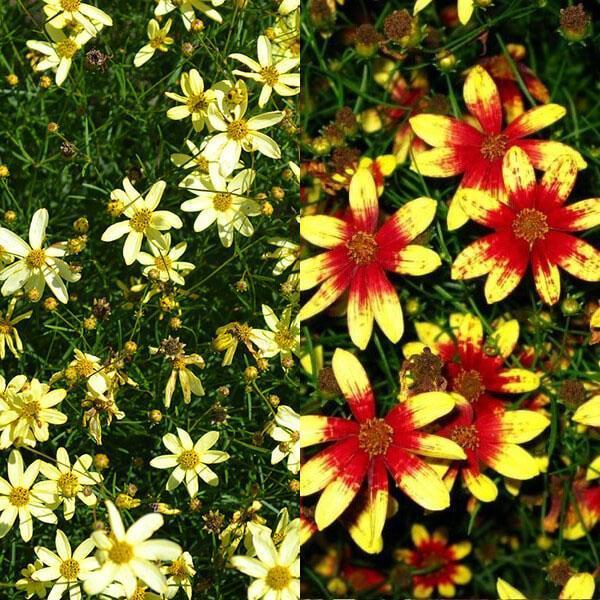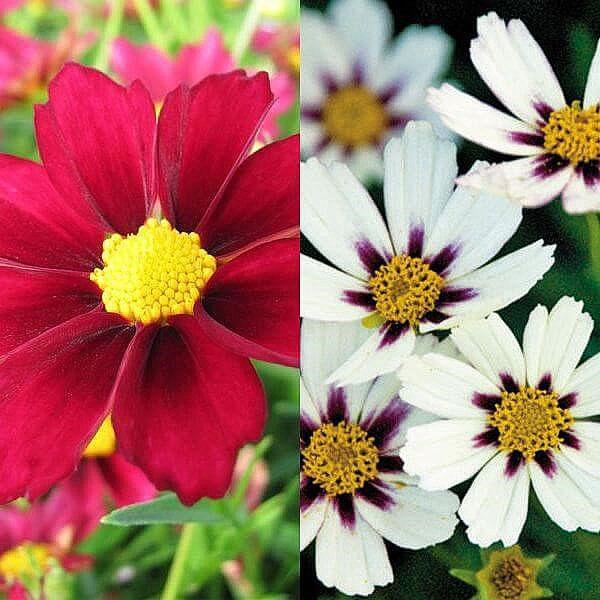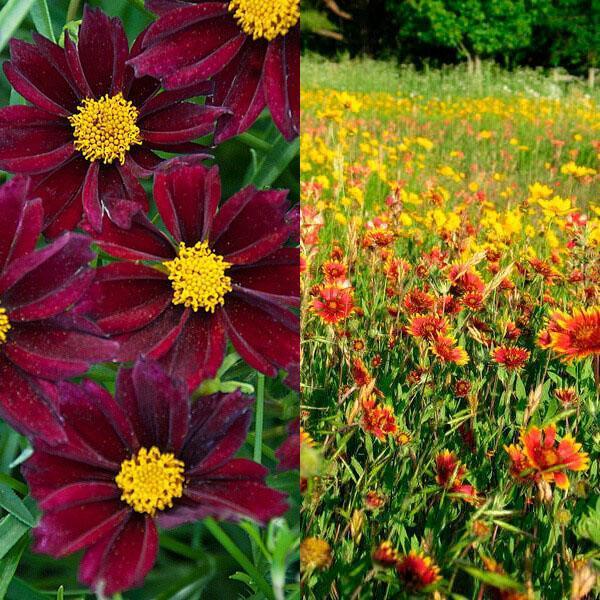The original decoration of the suburban area - the bright lights of coreopsis
 Probably, many will agree that, as many flowers on the planet, they have the same number of fans. Some people like roses, others like daisies, and the light-loving coreopsis has won the sincere hearts of summer residents. When daffodils and tulips disappear into oblivion, bright lights of cute flowers appear on the beds. It seems that tiny particles of the sun have descended from the sky, have successfully sprouted to charm good people. From the unearthly aroma of inflorescences, the kindest feelings arise in the soul, and from the pleasure you want to sing songs.
Probably, many will agree that, as many flowers on the planet, they have the same number of fans. Some people like roses, others like daisies, and the light-loving coreopsis has won the sincere hearts of summer residents. When daffodils and tulips disappear into oblivion, bright lights of cute flowers appear on the beds. It seems that tiny particles of the sun have descended from the sky, have successfully sprouted to charm good people. From the unearthly aroma of inflorescences, the kindest feelings arise in the soul, and from the pleasure you want to sing songs.
It is quite simple to grow coreopsis on your site, since the plant is unpretentious in care and multiplies easily. The flower grows successfully in the open field, is distinguished by a variety of varieties and adorns the front garden until the first frost. Consider the basic rules of planting, care and popular types of flowers. Read the same about planting and caring for perennial primrose (photo).
A close acquaintance with the plant is the key to successful cultivation

 During the season, the plant can grow up to 1.2 meters in height. Some species reach only 40 cm. Outwardly, they are dense bushes, strewn with many buds. Coreopsis fruits are most often flat in shape. They resemble some types of bedbugs or ticks. The plant is grown in garden plots or city flower beds as the main decoration. About 28 species of this flower are found on the American continent. Despite this, coreopsis are in demand in Europe.
During the season, the plant can grow up to 1.2 meters in height. Some species reach only 40 cm. Outwardly, they are dense bushes, strewn with many buds. Coreopsis fruits are most often flat in shape. They resemble some types of bedbugs or ticks. The plant is grown in garden plots or city flower beds as the main decoration. About 28 species of this flower are found on the American continent. Despite this, coreopsis are in demand in Europe.
 When you look from the side at the buds of a plant, they resemble field daisies... This is only at first glance. Original flower head, decorated with petals on all sides. Each of them is framed by a serrated tip, which gives it a noble look.
When you look from the side at the buds of a plant, they resemble field daisies... This is only at first glance. Original flower head, decorated with petals on all sides. Each of them is framed by a serrated tip, which gives it a noble look.
The leaf plates and the color of the petals depend on the plant variety:
- large-flowered coreopsis is characterized by bright yellow petals of buds on high shoots;
- pink coreopsis has small leaves, a yellow middle, which is topped with pale pink petals;
- Coreopsis vertikilata is loved for its serrated leaf plates and thin buds that abundantly cover the plant.
 The coreopsis shown in the photo, the planting and maintenance of which does not require special skills, is truly striking in its beauty. There are several basic rules:
The coreopsis shown in the photo, the planting and maintenance of which does not require special skills, is truly striking in its beauty. There are several basic rules:
- sunny place;
- medium fertility soil;
- moderate but regular watering.
Coreopsis grows best on loose soil, so you should be wise when choosing a place to plant a plant.
Perennial coreopsis can be diluted in a summer cottage in two ways:
- by sowing seeds;
- growing seedlings.
The main thing is to provide the plant with regular watering, enough light and air. As a result, most of the summer, the summer cottage will be decorated with bright sun lights.
Simple ways to grow a flower
 To start planting and caring for perennial coreopsis, you need to know the basic principles of growing this plant. Although it is quite unpretentious and perfectly takes root in the wild, some nuances must be taken into account.
To start planting and caring for perennial coreopsis, you need to know the basic principles of growing this plant. Although it is quite unpretentious and perfectly takes root in the wild, some nuances must be taken into account.
First of all - the choice of location. There should be a lot of light on it, as Coreopsis call the children of the sun. Some species can be planted next to tall trees. These include the pink and whorled appearance of the flower. A small shadow is not a hindrance for them. Perennial coreopsis, the photo of which is shown below, miraculously tolerates mid-latitude winters. Therefore, he does not need additional shelter.
The next nuance is the composition of the soil. Although the plant is unpretentious, it still needs useful elements and high-quality moisture. Therefore, land that retains water is not suitable for growing a sun flower.
A photo of a long-term coreopsis, the planting and care of which is carried out correctly, causes unprecedented admiration. A few simple rules will help you achieve this result.  You can grow a flower by sowing seeds directly in open ground or for seedlings. In the first case, the planting material is lowered into the soil in spring or autumn. Since the seeds are frost-resistant, winter is not an obstacle for them.
You can grow a flower by sowing seeds directly in open ground or for seedlings. In the first case, the planting material is lowered into the soil in spring or autumn. Since the seeds are frost-resistant, winter is not an obstacle for them.
A plant planted in this way will bloom only after a year. If you don't want to wait that long, it is better to use seedlings.
 Coreopsis fans who want to enjoy its beauty this summer use the seedling method. For this, containers with fertile soil are prepared in early spring. Then the seeds are laid out on the surface, lightly pressed with fingers, covered with sand and sprayed with water. To create a greenhouse environment, containers are covered with plastic wrap or glass.
Coreopsis fans who want to enjoy its beauty this summer use the seedling method. For this, containers with fertile soil are prepared in early spring. Then the seeds are laid out on the surface, lightly pressed with fingers, covered with sand and sprayed with water. To create a greenhouse environment, containers are covered with plastic wrap or glass.
They also practice planting seeds in peat tablets... When seedlings appear, they leave the strongest sprout. The rest are cut with nail scissors.
 Growing from seeds of large-flowered coreopsis is carried out in a well-lit room. The temperature should not be lower than 15 ° С. Crops are regularly sprayed with a hand spray. When the first shoots appear, the glass is removed. During the first 14 days, seedlings are dived. The distance between them is about 2 cm. When the greenery rises to 12 cm in height, the flower is planted in pots, and when it takes root in the open ground.
Growing from seeds of large-flowered coreopsis is carried out in a well-lit room. The temperature should not be lower than 15 ° С. Crops are regularly sprayed with a hand spray. When the first shoots appear, the glass is removed. During the first 14 days, seedlings are dived. The distance between them is about 2 cm. When the greenery rises to 12 cm in height, the flower is planted in pots, and when it takes root in the open ground.
Some types of coreopsis seedlings are sick with Black Leg. The main reason is excess moisture. Therefore it should be watered sparingly and judiciously.
Before planting a flower on a site, it is advisable to harden it. For this, containers are periodically taken out into the open air. When the threat of frost has passed, the seedlings are planted in open ground at a distance of 60 cm from each other. Almost any type of coreopsis can be grown with seedlings.
In some cases, gardeners also use vegetative propagation of the plant. To do this, in the middle of autumn it is dug up and divided into several parts. Then they are laid out in the holes and covered with earth. This method is used once every 3 years to preserve the decorative effect of the sunny flower.
Popular types of coreopsis
 According to botanists, about 100 varieties of this colorful plant are known in the wild. In gardening, only about 30 are used. Each of them has its own peculiarity, unique beauty and attractiveness. Let's consider the most popular types.
According to botanists, about 100 varieties of this colorful plant are known in the wild. In gardening, only about 30 are used. Each of them has its own peculiarity, unique beauty and attractiveness. Let's consider the most popular types.
An elegant highlight of the garden
 So you can call the whorled coreopsis, which is a branched bush 100 cm high and up to 60 cm wide.It is decorated with light green oblong leaves that resemble needles. The yellow reed petals of the buds are located around the brown core, which gives the plant an original look. The maximum size of the inflorescence is approximately 5 cm. The first ones appear in early June. The latter are in mid-autumn.In its natural environment, this variety of coreopsis is found in the southeastern United States. The flower is propagated using seedlings and sowing seeds in open ground.
So you can call the whorled coreopsis, which is a branched bush 100 cm high and up to 60 cm wide.It is decorated with light green oblong leaves that resemble needles. The yellow reed petals of the buds are located around the brown core, which gives the plant an original look. The maximum size of the inflorescence is approximately 5 cm. The first ones appear in early June. The latter are in mid-autumn.In its natural environment, this variety of coreopsis is found in the southeastern United States. The flower is propagated using seedlings and sowing seeds in open ground.
This sunny flower feels great in one place for 6 years.
 There are several varieties of this flower. For example, Ruby Red whorled coreopsis has bright red buds with toothed petals. The central part of the flower is colored orange or red. The narrow leaf plate is glamorously divided in half by a longitudinal vein. The plant is resistant to cold weather, develops well in partial shade and is unpretentious to the type of soil.
There are several varieties of this flower. For example, Ruby Red whorled coreopsis has bright red buds with toothed petals. The central part of the flower is colored orange or red. The narrow leaf plate is glamorously divided in half by a longitudinal vein. The plant is resistant to cold weather, develops well in partial shade and is unpretentious to the type of soil.
Yellow lights of the sun flower
 Coreopsis lanceolate got its name from the original shape of the leaves. They are collected in small bunches in the root region of the stem. The color is most often pale green, although there are species with a more saturated color.
Coreopsis lanceolate got its name from the original shape of the leaves. They are collected in small bunches in the root region of the stem. The color is most often pale green, although there are species with a more saturated color.
Its buds are drooping, semi-double. In diameter - up to 6 cm. Painted in bright yellow (sometimes with burgundy blotches). Inflorescences grow on single shoots 60 cm long in late summer. In nature, the flower grows in the USA, Canada and in some areas of Mexico. It was introduced to the Japanese islands as a decorative culture. It is now widely used in various landscape projects.
A gentle gift for novice gardeners
 Coreopsis large-flowered perfectly takes root on any kind of soil. In its natural environment (southeastern United States), it can be seen in open grasslands and along roads. The flower withstands the summer heat without losing its delicate beauty. The salt and the wind of the seaside are well tolerated. It is grown on city streets, backyards and even on rooftops, which is very fashionable lately.
Coreopsis large-flowered perfectly takes root on any kind of soil. In its natural environment (southeastern United States), it can be seen in open grasslands and along roads. The flower withstands the summer heat without losing its delicate beauty. The salt and the wind of the seaside are well tolerated. It is grown on city streets, backyards and even on rooftops, which is very fashionable lately.
 Coreopsis grows up to 1 m in height. Has erect branched shoots. The leaf plate is pinnately dissected. The yellow, basket-shaped buds are composed of reed tubular petals that appear in mid-summer. In order to constantly enjoy the sunny flower on the site, it is advisable to regularly update the bushes. Experienced gardeners do this every 3 years. After listening to the advice of experts, you can successfully grow these delicate flowers in your summer cottages.
Coreopsis grows up to 1 m in height. Has erect branched shoots. The leaf plate is pinnately dissected. The yellow, basket-shaped buds are composed of reed tubular petals that appear in mid-summer. In order to constantly enjoy the sunny flower on the site, it is advisable to regularly update the bushes. Experienced gardeners do this every 3 years. After listening to the advice of experts, you can successfully grow these delicate flowers in your summer cottages.